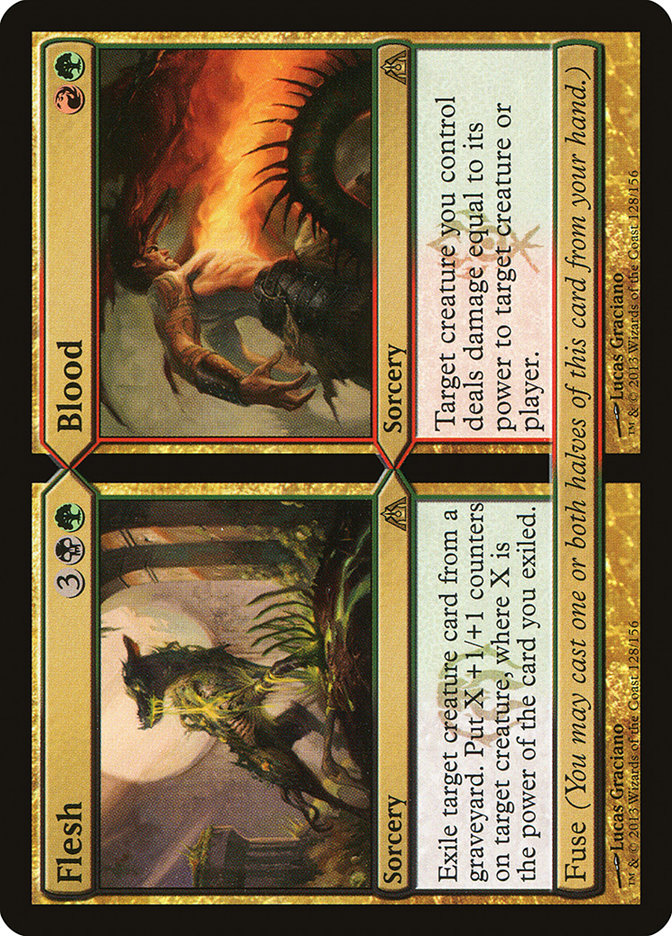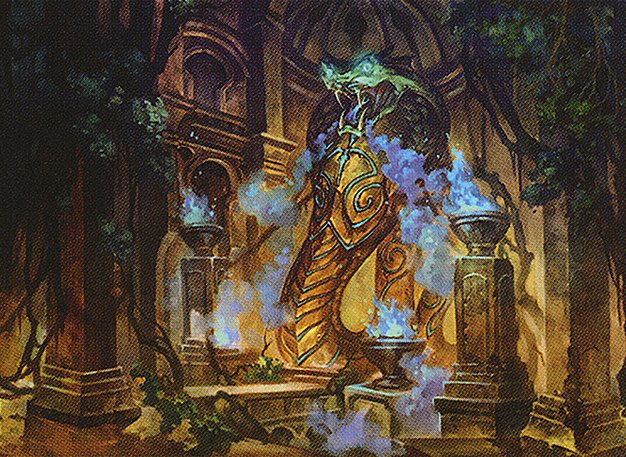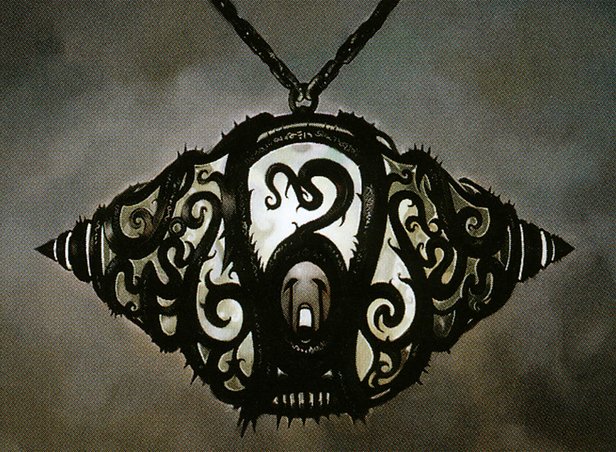Flesh // Blood MTG Card
| Card sets | Released in 2 setsSee all |
| Mana cost | |
| Converted mana cost | 7 |
| Rarity | Rare |
| Type | Sorcery |
| Abilities | Fuse |
Key Takeaways
- Offers card advantage by providing two potential actions within a single card’s design.
- Instant speed casting of both parts adds unexpected flexibility during gameplay.
- Casting requirements and mana costs require thoughtful deck construction and timing.
Text of card
Target creature you control deals damage equal to its power to target creature or player. Fuse (You may cast one or both halves of this card from your hand.)
Card Pros
Card Advantage: The split nature of Flesh // Blood enables two actions from a single card, contributing to significant card advantage as you utilize its capabilities to adapt to the current state of the game.
Resource Acceleration: Blood’s aspect can utilize existing creatures to accelerate damage, turning your creatures into potential resources for controlling the game’s pace and threatening your opponent’s life total without the need to commit additional cards.
Instant Speed: Both halves of this versatile card can be cast at instant speed, offering flexibility in response to game developments. You can surprise an opponent by removing a threat or swinging the combat phase in your favor at a moment’s notice.
Card Cons
Discard Requirement: Flesh // Blood requires a creature card to be exiled from your graveyard as part of its casting cost. This can lead to a decrease in strategic options later in the game, especially in formats where graveyard recursion is key.
Specific Mana Cost: The hybrid mana cost for Flesh is specific to red and green, which may not be as flexible for decks that aren’t based around these colors. This can restrict the usability of the card to specific archetypes, limiting versatility.
Comparatively High Mana Cost: For its Blood half, the mana cost can be considered high given the card’s effect. In a fast-paced game, the combined mana expenditure to potentially remove a creature and deal direct damage may not be as cost-effective compared to other options available in the card pool.
Reasons to Include in Your Collection
Versatility: Flesh // Blood offers a unique two-in-one option for decks that require flexibility. The split card design allows players to choose between beefing up a creature or dealing direct damage, based on the needs of the moment.
Combo Potential: This card shines in synergistic strategies, enabling players to remove blockers with the ‘Flesh’ half and then push for lethal damage using ‘Blood’ in combination with a high-powered creature on board.
Meta-Relevance: Given its ability to act as both a combat trick and a finisher, Flesh // Blood can be surprisingly effective in matchups against control decks or in races against other aggressive decks.
How to beat
Flesh // Blood is a versatile split card that can pose unique challenges on the battlefield in MTG. When facing this card, it’s crucial to assess the context in which it’s played to develop an effective counterstrategy. One effective way to minimize the impact of Flesh // Blood is to maintain control over the number of creatures your opponent has in play. Flesh, with its ability to remove creatures from the game and bolster another, can be mitigated by ensuring your opponent has fewer targets to work with. Additionally, prioritizing the removal of their larger threats can prevent a devastating blow from Blood’s targeting ability.
Another tactic involves utilizing graveyard hate cards to impede your opponent’s access to potential Flesh targets. Cards that exile graveyard contents can be particularly effective. In the case of Blood, direct damage can be prevented by using cards that give your creatures indestructibility or hexproof for a turn. Plan to have instant-speed responses ready to protect your creatures or disrupt your opponent’s strategy. By anticipating Flesh // Blood and deploying timely counters or preventive measures, you can maintain an advantage and work towards victory despite its potential power.
BurnMana Recommendations
Delving into the mechanics of Flesh // Blood offers MTG players a dynamic tool for shaping game outcomes. The combination of bolstering your battlefield presence and dealing a direct blow makes this card an asset for red-green enthusiasts. When considering deck enhancements or sourcing strategic spells, Flesh // Blood exemplifies the ingenuity that’s possible within MTG. For those who enjoy crafting unexpected turns and revel in the intricacies of combat, this split card is a compelling addition to consider. Ready to exploit its full potential? Dive deeper with us and elevate your MTG experience.
Understanding Flesh // Blood in Context
Flesh // Blood stands out in Magic: The Gathering as a versatile split card that can be a game-changer in matches. It’s akin to other creature-focused spells, but has a distinctive twist. For example, Assault // Battery lets you summon a creature or deal damage, similar to Blood’s capability. However, Flesh // Blood allows for an explosive interaction by letting a creature deal damage equivalent to its power to another target.
Cards like Flesh // Blood
When examining cards with abilities comparable to Flesh // Blood, Prey Upon comes to mind as it allows a creature to fight another creature. While Prey Upon is straightforward and inexpensive, it differs from Flesh because it requires your creature to both deal and take damage. Another parallel can be drawn with Fall of the Hammer, which, like Blood, permits direct damage without your card taking damage in return, though it lacks the flexibility of casting two spells from a single card.
In evaluating the trade-offs against similar cards, Flesh // Blood offers a combination of aggressive repositioning of your creatures and direct damage potential. It becomes evident that for players who enjoy tactical flexibility and surprise plays, Flesh // Blood is an innovative addition to creature interaction spells in Magic: The Gathering.
Cards similar to Flesh // Blood by color, type and mana cost
Where to buy
If you're looking to purchase Flesh // Blood MTG card by a specific set like Dragon's Maze and The List, there are several reliable options to consider. One of the primary sources is your local game store, where you can often find booster packs, individual cards, and preconstructed decks from current and some past sets. They often offer the added benefit of a community where you can trade with other players.
For a broader inventory, particularly of older sets, online marketplaces like TCGPlayer, Card Kingdom and Card Market offer extensive selections and allow you to search for cards from specific sets. Larger e-commerce platforms like eBay and Amazon also have listings from various sellers, which can be a good place to look for sealed product and rare finds.
Additionally, Magic’s official site often has a store locator and retailer lists for finding Wizards of the Coast licensed products. Remember to check for authenticity and the condition of the cards when purchasing, especially from individual sellers on larger marketplaces.
Below is a list of some store websites where you can buy the Flesh // Blood and other MTG cards:
- eBay
- TCG Player
- Card Kingdom
- Card Market
- Star City Games
- CoolStuffInc
- MTG Mint Card
- Hareruya
- Troll and Toad
- ABU Games
- Card Hoarder Magic Online
- MTGO Traders Magic Online
See MTG Products
Printings
The Flesh // Blood Magic the Gathering card was released in 2 different sets between 2013-05-03 and 2013-05-03. Illustrated by Lucas Graciano.
| # | Released | Name | Code | Symbol | Number | Frame | Layout | Border | Artist |
|---|---|---|---|---|---|---|---|---|---|
| 1 | 2013-05-03 | Dragon's Maze | DGM | 128 | 2003 | Split | Black | Lucas Graciano | |
| 2 | The List | PLST | DGM-128 | 2003 | Split | Black | Lucas Graciano |
Legalities
Magic the Gathering formats where Flesh // Blood has restrictions
| Format | Legality |
|---|---|
| Commander | Legal |
| Legacy | Legal |
| Modern | Legal |
| Oathbreaker | Legal |
| Vintage | Legal |
| Duel | Legal |
| Pioneer | Legal |
| Penny | Legal |
Rules and information
The reference guide for Magic: The Gathering Flesh // Blood card rulings provides official rulings, any errata issued, as well as a record of all the functional modifications that have occurred.
| Date | Text |
|---|---|
| 2013-04-15 | As Blood is resolving, if only one of the targets is legal, Blood will still resolve but will have no effect: If the first target is illegal, it can’t deal damage to anything. If the second target is illegal, it can’t be dealt damage. |
| 2013-04-15 | As Flesh is resolving, if the creature is an illegal target but the creature card is still a legal target, the creature card will be exiled but no counters will be put onto the creature. If the creature is the only legal target, Flesh will still resolve but will have no effect as you didn’t exile a card. |
| 2013-04-15 | If a player names a card, the player may name either half of a split card, but not both. A split card has the chosen name if one of its two names matches the chosen name. |
| 2013-04-15 | If you cast Flesh // Blood as a fused split card, the +1/+1 counters will have been placed before the amount of damage is determined. |
| 2013-04-15 | If you cast a split card with fuse from your hand without paying its mana cost, you can choose to use its fuse ability and cast both halves without paying their mana costs. |
| 2013-04-15 | If you’re casting a split card with fuse from any zone other than your hand, you can’t cast both halves. You’ll only be able to cast one half or the other. |
| 2013-04-15 | On the stack, a split spell that hasn’t been fused has only that half’s characteristics and converted mana cost. The other half is treated as though it didn’t exist. |
| 2013-04-15 | Some split cards with fuse have two halves that are both multicolored. That card is multicolored no matter which half is cast, or if both halves are cast. It’s also multicolored while not on the stack. |
| 2013-04-15 | Some split cards with fuse have two monocolor halves of different colors. If such a card is cast as a fused split spell, the resulting spell is multicolored. If only one half is cast, the spell is the color of that half. While not on the stack, such a card is multicolored. |
| 2013-04-15 | The amount of damage dealt is based on the first target creature’s power as Blood resolves. |
| 2013-04-15 | The number of +1/+1 counters is based on the power of the creature card as it last existed in the graveyard. |
| 2013-04-15 | To cast a fused split spell, pay both of its mana costs. While the spell is on the stack, its converted mana cost is the total amount of mana in both costs. |
| 2013-04-15 | When a fused split spell resolves, follow the instructions of the left half first, then the instructions on the right half. |
| 2013-04-15 | When resolving a fused split spell with multiple targets, treat it as you would any spell with multiple targets. If all targets are illegal when the spell tries to resolve, the spell doesn’t resolve and none of its effects happen. If at least one target is still legal at that time, the spell resolves, but an illegal target can’t perform any actions or have any actions performed on it. |
| 2013-04-15 | You can choose the same object as the target of each half of a fused split spell, if appropriate. |















